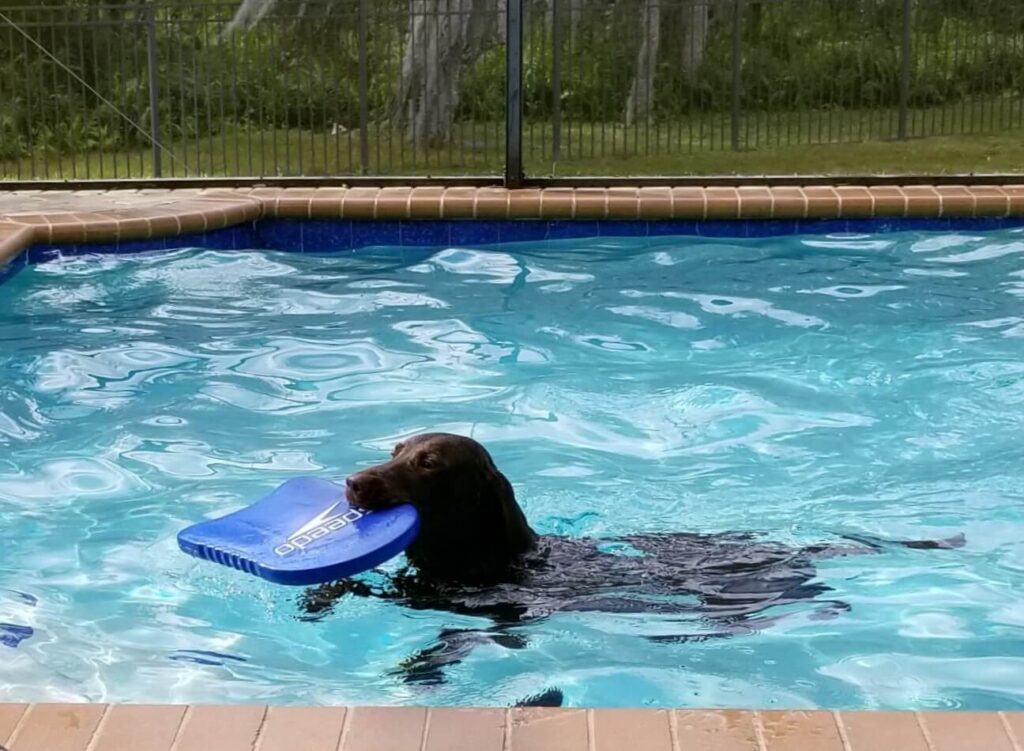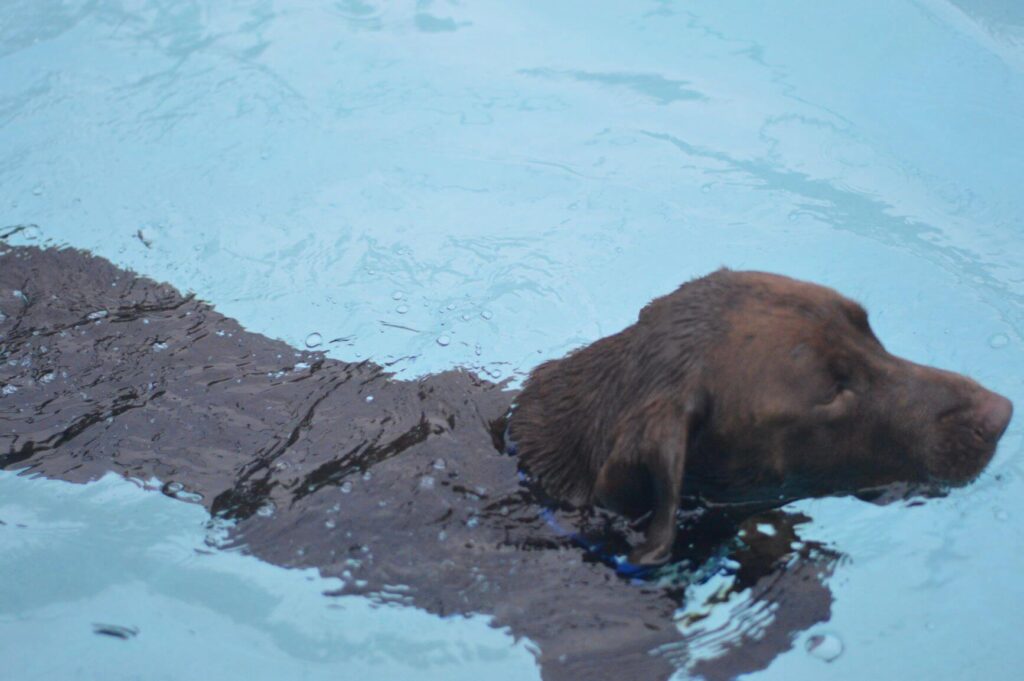Labradors are playful and energetic dogs, and that often translates to a remarkable love of water activities.
Do Labradors like to swim?
Usually yes, Labradors love to play in the water, but you might need to teach your Labrador to swim, as it may not come naturally at first. This is especially true if you have a Labrador puppy. It might be something that takes your particular Lab a little bit of time to learn.
After all, not all dogs love the water, and your Lab may be one who doesn’t feel comfortable just yet going for a swim.
(This article may contain affiliate links. As an Amazon Associate I earn from qualifying purchases. Learn more)
In this article, we’ll take a look at the history of water and the Labrador Retriever breed, and how to properly introduce your Labrador, or Lab puppy, to swimming.
We’ll also give you some tips to help your Lab have fun and stay safe in the water and develop a lifelong love of swimming.
Do Labradors Like to Swim?
Yes, most Labrador Retrievers absolutely love the water and are usually happy to jump in whenever they get the opportunity to go for a swim.
Labradors are typically a very playful, friendly, and easygoing dog breed, and they often will join in when anyone else in the family goes for a swim.
If you have access to water on your property or near your home, you might have trouble keeping your Labrador OUT of the water, rather than worrying about them not enjoying it.
Labradors enjoy lakes, dog beaches, and backyard swimming pools, as well as creeks and rivers. Even cold water won’t be much of a deterrent to them, as they have a double coat to give them some additional protection from cold water temperatures.
If you have kids and bring out the sprinkler, water toys, or the baby pool, you might have a very excited Labrador on your hands ready to join in on the fun!
Labrador Traits That Help Them Excel in the Water
Labrador Retrievers were originally bred in Canada several hundred years ago to be water retrievers in the very cold waters of the north.
As discussed above, Labs have a thick protective double coat of fur, which can result in a lot of dog shedding around your home but gives them ample protection in colder water temperatures for short periods of time. They still can get cold though, when in colder waters for longer periods.
Labs also have a thick otter-like tail, which gives them the ability to steer themselves when moving through water. They have a definite advantage in the water with their otter tail over other types of retrievers with shorter tails, such as Pointers.
Labs also have long legs and thick chests, which allow them to power through the water with fairly good strength and speed. Their large heads allow them to keep their ears and noses out of the water while being able to see in which direction they are swimming.
Another great feature of the Labrador that helps them excel in the water is their webbed feet! Having webbed feet allows a Lab to push more water with their paws than other dogs with non-webbed feet.
If you’ve been in a pool or a lake with a Lab, and have observed their paws underwater, you will see they stretch and extend their webbed feet outwards to maximize how much water they can move with them.
The Labrador anatomy is well-designed for excellence in the water. Their playful personalities and love of retrieving also allow them to enjoy swimming and splashing in the water.

Do You Have to Teach a Lab to Swim?
While Labradors generally develop a strong love for the water, they aren’t necessarily born knowing exactly how to swim already.
Yes, you definitely may need to help teach your Labrador to swim if you have a new puppy or are adopting an older adult Labrador who does not have much prior experience with water.
We adopted a chocolate Labrador rescue who had likely never been exposed to water deeper than a foot or two. When given the chance to jump in and start swimming in our backyard pool, he didn’t hesitate… except once in the water, he had no idea what to do.
We started him in the shallow end and taught him to do “doggie paddle,” which you would think would be instinctive, but again, every dog is different.
For our rescue boy, he actually tried to swim vertically (straight up and down) by bouncing off the bottom of the pool with his back paws, and pushing himself up and down across the surface.
We had to help him by getting in the water with him and teaching him to swim horizontally, by using his paws to paddle.
At our big rescue boy was almost 100 lbs, this required a few people to help and a large stack of towels!
Within a half-hour or so, he had figured out the general idea of how to swim, and then would jump into the pool every chance he could get! He also proceeded to begin several years of retrieving and destroying every pool toy and product around the pool deck.
Can Labrador Puppies Swim?
Labrador puppies can be introduced to the water at a few months old, within a few weeks after you get them into your home, but they may not respond with confidence at first.
It may take a bit of time and patience for Lab puppies to learn what to do in the water, and you’ll want to make sure you don’t traumatize them or scare them by forcing them into too-deep water before they are ready.
4 Steps to Teach Your Lab Puppy to Swim
Ready to get started introducing your Labrador to swimming? Here are four steps to take to encourage your Lab to become a great swimmer and develop a love for the water.
1. Begin Slowly
To teach a Lab puppy to swim, begin with just a few inches of water either indoors or outside, and make it a fun splashing adventure.
Add more water after your pup seems to be enjoying themselves. You can even start in the bathtub with their first bath time, making it a playful and fun experience.
2. Use Toys & Outdoor Space
If the weather is warm, you can take your Lab puppy outside and fill a baby pool, which you can find at many stores for around $10-$15.
Make sure the water temperature is not too hot or too cold, and make it a game for your puppy.
Use toys or tennis balls to entice the puppy to play in the water. If you’ve already been working on some retrieving games, throw the fetch toy into the water and encourage your puppy to go splash and retrieve it. You might also get into the water yourself (or have your kids get in) and see if the puppy is more eager to join them.
3. Keep It Positive
Don’t force the puppy into the water if they hesitate. Keep trying in a positive way and your puppy with grow to love the water. Don’t worry if at the beginning your young Labrador puppy doesn’t immediately love the water in the first few months.
Depending on the temperament of your individual dog, they may just take more time to warm up to a new situation and will likely grow to love the water later.
We’ve heard from fellow Labrador owners whose dogs didn’t seem that crazy about the water at first, but now over time, their Labs have grown to love it and will protest if they see their family members try to jump in the pool without them!
Be aware that Labs may also try to drink a lot of the pool water. If you have a salt water swimming pool, or you’re taking them to the ocean, keep in mind that drinking a lot of this salty water can dehydrate them!
4. Always Monitor the Surroundings
You’ll also want to be aware of any animals or marine life that can pose a danger to your dog, especially if it’s a younger puppy.
We’ve lived in an area of the southern United States where both alligators and water moccasins (a type of snake) posed a danger to people’s pets. Keep your eyes out for any creatures before you choose to let your Labrador in the water.
Also talk with your veterinarian about whether giardia and leptospirosis are illnesses that you should be concerned about if you’re allowing your dog into bodies of water that might be stagnant or have some types of bacteria that may make them sick. There may be vaccines for both that your vet might recommend, depending on your dog and your location.
How Do I Help My Lab Love the Water?
You can help your Labrador love the water by creating a positive experience around water and making it fun for them.
Labs love to retrieve and may be more excited to retrieve in water than on land. If you have access to a lake, a dog beach, or a creek, begin by taking your dog on a leash to those locations, and letting them play to get comfortable.
Just watch out for any critters in the water that may pose a threat to your dog, and keep an eye on your Lab to prevent them from eating grass, which could make them sick.
Sometimes retrievers can overdo it in the water and develop a condition called Droopy Tail Syndrome (also called Limber Tail Syndrome). Learn how to identify it and how to prevent this overuse tail injury in your Lab!
Throw a tennis ball, a dog toy, or a floating retriever bumper, to encourage your Lab to jump in, fetch, and return it back to you. Exercise in the water will also definitely tire your Labrador out!
In dealing with hot summer weather, getting your Lab in the pool, or making a fun adventure of heading to the lake, creek, or river, is one of our best tips to help your Labrador keep cool in the summer and deal with hot temperatures.
If you live in a city without access to a beach, creek, or lakes, see if any of your community swimming pools offer end-of-the-season “dog splashes” where you can bring your dog to swim in the pool.
These events are usually at the end of summer, before the pool is closed down for the winter season, and can be a fun way for your dog to burn off some energy while playing in the water with other dogs. It can be a fun way for you to introduce a city dog to the water too!

Summary – Do Labradors Like to Swim?
Yes, Labradors are a breed known to excel as water dogs, and usually love to be in and around water.
Some of this will depend on the exact personality of your individual dog, but most Labs will grow to love to swim and be in the water, even if they initially are hesitant.
You can encourage your Lab to swim and love the water by beginning slowly with their introduction to water, making it fun for them, and playing retrieving games to help them get excited.
Before long, you’ll be trying to figure out how to keep your dog OUT of the water because they’ve grown to love to swim so much!







